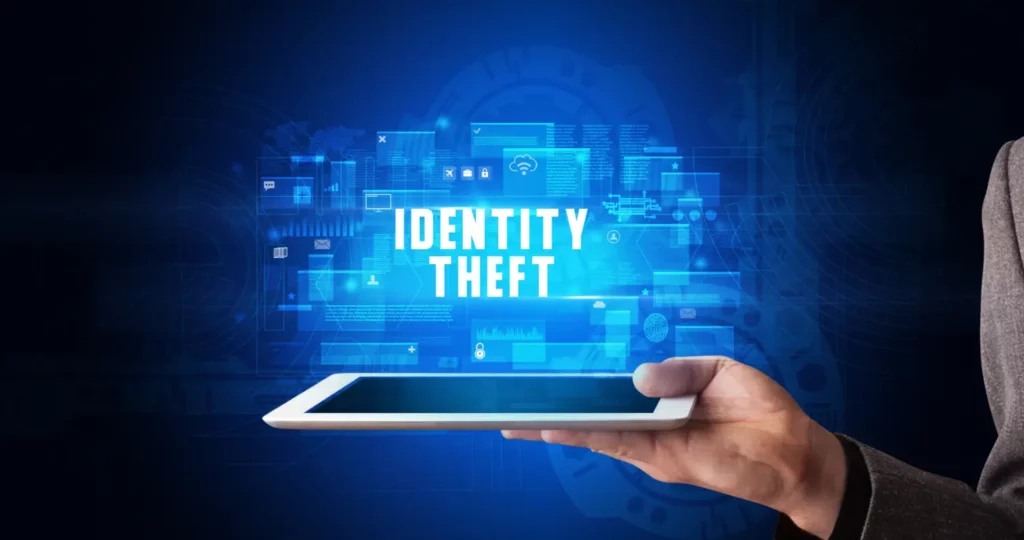
Identity theft is not just a buzzword; it’s a real issue affecting many people today. Stats show nearly 2 in 5 of us may fall victim to identity theft at some point. Our guide will steer you through advanced strategies to shield your personal info from prying eyes.
Keep reading for keys to lock down your privacy tight.
Key Takeaways
- Identity theft is a growing problem that can lead to financial loss and reputational damage, making it essential to use advanced protection strategies.
- Freezing your credit, using strong passwords, enabling two-factor authentication, and subscribing to identity theft protection services are key steps in securing personal information.
- Regularly monitoring your accounts and being aware of the signs of identity theft can help you act quickly if your identity is compromised.
- In the event of identity theft, reporting the incident immediately and contacting financial institutions are crucial for limiting damage and starting recovery processes.
- Investing in comprehensive identity theft protection services with features like dark web surveillance and real-time fraud alerts provides an extra layer of security.
Understanding Identity Theft
Identity theft occurs when someone steals or uses your personal information without permission. This can include stealing your social security number, credit card numbers, or even medical records.
It’s important to be aware of common types of identity theft and the warning signs to look out for.
What is it?
Identity theft is when someone uses your personal details without your permission to commit fraud or other crimes. Thieves might steal credit card numbers, bank account information, or Social Security numbers to take over accounts, make purchases, or create new identities.
It’s not just about losing money; the effects can be far-reaching and may include damage to your credit score and reputation.
Protecting yourself involves more than watching bank statements for unfamiliar charges. Cybersecurity practices like using strong passwords and enabling two-factor authentication help shield online accounts from hackers.
Regularly monitoring your identity can alert you to any suspicious activities before they escalate into bigger problems. Services designed for seniors’ identity theft protection specifically cater to the unique risks faced by older internet users.
With cybercrime growing more sophisticated, staying informed and proactive in personal information protection becomes crucial for everyone – parents educating their children, office workers securing their data, and individuals enjoying the digital world safely.
Common Types of Identity Theft
Understanding what identity theft is leads us to recognise the various common types of identity theft that can occur. Here are the different ways in which identity theft can manifest:
- Credit card fraud, where unauthorised purchases are made using stolen credit or debit card information.
- Social Security number theft, allowing fraudsters to open new accounts or commit other crimes under your identity.
- Medical identity theft, where someone uses your personal information to obtain medical services or prescription drugs.
- Tax identity theft involves a scammer filing a fraudulent tax return using your Social Security number to claim a refund.
- Criminal identity theft occurs when someone commits a crime and provides your personal information to law enforcement when apprehended.
- Child identity theft happens when a child’s Social Security number is used to apply for government benefits, gain employment, or open bank accounts.
Warning Signs to Look out for
- Unexplained withdrawals or charges on your bank account or credit card statements.
- Receiving bills or collection notices for unfamiliar accounts or services.
- Unexpected denial of credit or loan applications.
- Not receiving important mail, such as bills and statements.
- Errors on your credit report, such as unknown accounts or incorrect personal information.
- Suspicious activity on your social media or email accounts, such as unrecognised logins.
- Getting contacted about debts that aren’t yours.
Prevention Techniques
Protecting your sensitive information, using strong passwords and enabling two-factor authentication are crucial steps in preventing identity theft. Freezing your credit is also a powerful tool to stop fraudsters from accessing your financial information.
Freezing Credit
To protect your credit from unauthorised access, consider freezing it. Freezing your credit prevents lenders from accessing your credit report, making it difficult for identity thieves to open new accounts in your name.
This is a proactive step that adds an extra layer of security to safeguard against potential identity theft. By freezing your credit, you can take control and prevent unauthorised use of your personal information.
Identity theft protection services often include the ability to freeze and unfreeze credit as part of their offerings. It’s an effective way to prevent fraudulent activity and gives you peace of mind knowing that your financial information is secure.
Safeguarding Sensitive Information
After taking steps to freeze your credit, it is crucial to continue safeguarding sensitive information from potential identity theft. One effective method is to regularly monitor bank and credit card statements for any suspicious activity.
By checking these statements frequently, you can catch unauthorised transactions before they escalate into a bigger problem. Additionally, consider using a shredder to dispose of documents containing personal information such as bank statements and utility bills, preventing thieves from accessing this sensitive data.
Another important aspect of safeguarding sensitive information involves being cautious when sharing personal details online. Be wary of providing personal information on social media platforms or other websites unless absolutely necessary.
Using Strong Passwords
Creating strong and unique passwords is crucial in protecting your personal information from identity theft. When you use a combination of uppercase and lowercase letters, numbers, and special characters, it makes it harder for hackers to crack your password.
This can help prevent unauthorised access to your accounts and sensitive data.
Enabling two-factor authentication adds an extra layer of security by requiring a second form of verification, such as a code sent to your mobile device. This further reduces the risk of unauthorised access even if someone manages to obtain your password.
Enabling Two-Factor Authentication
After using strong passwords to protect personal information, another layer of security can be added by enabling two-factor authentication. This additional step requires users to provide a second form of identification, such as a unique code sent to their phone or email, in addition to the usual password.
By doing so, individuals significantly reduce the risk of unauthorised access even if their password is compromised. It’s an effective way to add an extra level of security and safeguard sensitive accounts from potential breaches.
Investing in two-factor authentication not only enhances online security but also provides peace of mind for individuals who want to protect themselves from identity theft. This proactive measure aligns with best practices for online identity theft prevention and adds an extra barrier against unauthorised access.
How Identity Theft Can Occur
Identity theft can occur in various ways, such as losing or having your wallet stolen, falling victim to data breaches, phishing and spoofing scams, or malware attacks. Understanding how it can happen is crucial in protecting yourself from identity theft.
Lost or Stolen Wallet
Losing or having your wallet stolen can expose you to identity theft risks. It’s important to take immediate action to minimise the potential damage and protect your personal information. Here’s what you should do:
- Contact your bank and credit card companies to report any missing debit or credit cards, and request new ones.
- Place a fraud alert on your credit reports with one of the major credit bureaus, which will notify the others.
- File a police report in case of theft, as it provides legal documentation of the incident.
- Monitor your accounts regularly for any unauthorised transactions or activity.
- Replace any lost identification documents such as driver’s licence or passport by contacting the relevant authorities.
- Consider using an identity theft protection service to monitor for any misuse of your personal information, including that found on the Dark Web.
Data Breaches

Data breaches pose a significant threat to personal information security. Hackers can gain unauthorised access to sensitive data, including financial details and personal identifiers, through various cyber-attacks.
As a result, individuals can fall victim to identity theft and other fraudulent activities. It’s crucial for everyone to remain vigilant against data breaches by implementing strong password protection, enabling two-factor authentication where possible, and regularly monitoring credit reports for any suspicious activity.
Additionally, investing in reputable identity theft protection services that offer dark web scanning and fraud detection can provide an extra layer of security against potential data breaches.
Phishing and Spoofing
After understanding the risks associated with data breaches, it’s crucial to be aware of phishing and spoofing as common methods used by identity thieves. Phishing involves fraudsters posing as legitimate organisations through email, text messages, or phone calls to gain access to personal information.
On the other hand, spoofing occurs when scammers manipulate caller ID or email addresses to appear as a trusted source. It’s important for individuals to remain cautious and avoid clicking on suspicious links or sharing sensitive information in response to unsolicited requests.
To protect against phishing and spoofing attempts, it is essential to educate oneself about these tactics and regularly review tips on how to identify fraudulent communication. Implementing two-factor authentication whenever possible can add an additional layer of security against unauthorised access.
Malware
Malware is a significant threat to personal information security. It can secretly install itself on your devices, allowing hackers to access sensitive data. Protecting against malware involves using reputable antivirus software and being cautious when clicking on links or downloading files, particularly from unfamiliar sources.
Regularly updating software and operating systems, as well as running regular malware scans, are crucial steps in preventing malware attacks.
Identity theft protection services often include features such as dark web monitoring to detect if personal information is being traded illegally online due to a malware attack. Being proactive about safeguarding against malware can significantly reduce the risk of falling victim to identity theft and fraud.

Steps to Take in Case of Identity Theft
Report the incident to the relevant authorities and financial institutions, keep a record of all communication, and consider enlisting the help of an identity theft protection service.
Read on for more important information on protecting your identity beyond the basics.
Reporting the Incident
If you suspect that your identity has been stolen, it’s crucial to report the incident immediately. Contact the police to file a report and notify your bank or credit card company of any fraudulent activity.
By reporting the incident promptly, you can limit the potential damage and start the process of restoring your identity.
Once reported, expect to be provided with guidance on steps to take next and connect with an identity theft protection service for assistance in navigating through this challenging situation.
What to Expect
When facing identity theft, individuals can expect to experience a range of emotions, including frustration and concern over the potential damage caused by the theft. It’s important to be prepared for the possibility of significant financial losses and time-consuming efforts to restore one’s identity.
Expect to take immediate action by reporting the incident using official channels such as IdentityTheft.gov to mitigate further harm. Additionally, consider investing in reputable identity theft protection services that offer comprehensive monitoring and alert systems for early detection of suspicious activities related to personal information.
In cases of identity fraud, individuals can expect legal fees, lost wages, and expenses related to recovering their stolen identity. For seniors who may be particularly vulnerable targets for identity theft, it is crucial for them to have robust protection measures in place.

Best Identity Theft Protection Services
Identity theft protection services are vital in safeguarding your personal information against malicious activities. Here is a summary of some of the top services available:
| Service Name | Features | Insurance Coverage |
|---|---|---|
| LifeLock | Credit monitoring, alerts, dark web surveillance | Up to £1 million for legal fees, stolen funds |
| Identity Force | Two-factor authentication, real-time fraud alerts | Comprehensive insurance for expenses and lost wages |
| Experian Identity Works | Credit lock, credit score tracking, child identity monitoring | Coverage varies depending on plan |
| ID Watchdog | Public record monitoring, subprime loan alerts | 100% resolution guarantee |
| Identity Guard | Artificial intelligence monitoring, risk management report | Up to £1 million insurance with stolen funds reimbursement |
Individuals seeking identity theft protection would benefit from researching these options. Many services offer unique features tailored to different needs, such as family plans. These companies provide peace of mind through their monitoring capabilities and financial fraud protection assurances backed by insurance policies.
The Importance of Regularly Monitoring Your Identity and Credit
Regularly monitoring your identity and credit is crucial in detecting any suspicious activity or signs of identity theft. By staying vigilant, you can take immediate action to protect yourself and prevent further damage.
Options for Monitoring
To ensure comprehensive protection against identity theft, individuals should consider the following options for monitoring their personal information:
- Regularly review credit reports from all three major credit bureaus to check for any suspicious activity or unauthorised transactions.
- Subscribe to identity theft protection services that provide continuous monitoring of personal data and send alerts if any suspicious activity is detected.
- Set up account alerts with financial institutions and credit card companies to receive notifications for any unusual account activities.
- Utilise free credit monitoring services offered by some banks and credit card companies to keep track of changes in credit scores and reports.
- Monitor online accounts and social media platforms for any signs of unauthorised access or fraudulent activity.
Steps to Take if you are a Victim of Identity Theft
After understanding the options for monitoring, it is crucial to be aware of the steps to take if you fall victim to identity theft. Take immediate action by following these steps:
- Contact your financial institutions and credit bureaus to freeze your accounts and prevent further fraudulent activity.
- File a report with the Federal Trade Commission (FTC) at IdentityTheft.gov and obtain an Identity Theft Affidavit.
- Report the incident to the local police department and obtain a copy of the police report or case number as proof of the crime.
- Review your credit reports from all three major credit bureaus – Equifax, Experian, and TransUnion – to identify any unauthorised transactions or accounts opened in your name.
- Consider placing a fraud alert on your credit reports to notify potential creditors of the theft and to request additional verification when new accounts are opened.
- Document all correspondence and conversations related to the identity theft, including names, dates, and details of each interaction.
- Keep records of any expenses incurred due to the theft, such as legal fees, lost wages, or other costs associated with reclaiming your identity.
- Be cautious of potential scams targeting identity theft victims and seek guidance from legitimate resources for support and assistance during this challenging time.

In conclusion, protecting your identity goes beyond just monitoring credit reports. It involves taking proactive steps to prevent theft from happening in the first place. Using strong passwords and enabling two-factor authentication are simple yet effective measures in safeguarding personal information.
Regularly monitoring your identity and being vigilant for warning signs are crucial practices in staying safe from identity theft. Identity theft protection services can provide extra layers of security and peace of mind, especially in today’s digital age where the risk is prevalent.
FAQs
What is the Red Flags Rule in identity theft protection?
The Red Flags Rule requires businesses to spot and act on warnings that could signal identity theft, helping safeguard personal data and privacy.
Why should seniors consider special identity theft protection?
Seniors often face higher risks of fraud; hence senior identity protection focuses on specific measures to shield their personal information from thieves.
Can I find free services for protecting my identity?
Yes, there are free identity protection resources available, but it’s wise to check consumer reports on these services to ensure they’re reliable.
Is it worth getting identity theft insurance for extra security?
Investing in identity theft insurance can provide additional security by covering costs related to recovering your stolen identity and safeguarding your privacy.
